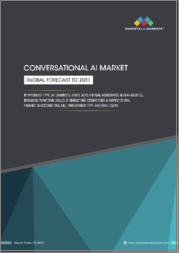
|
시장보고서
상품코드
1577194
대화형 AI 시장 예측(-2030년) : 오퍼링별, 도입 모드별, 대화 인터페이스별, 사용 사례별, 기술별, 최종사용자별, 지역별 세계 분석Conversational AI Market Forecasts to 2030 - Global Analysis By Offering, Deployment Mode, Conversational Interface (Chatbots, Intelligent Virtual Assistants and Interactive Voice Response Systems), Use Case, Technology, End User and By Geography |
||||||
Stratistics MRC에 따르면 세계의 대화형 AI 시장은 2024년에 116억 달러를 차지하며 예측 기간 중 CAGR은 23.9%로 성장하며, 2030년에는 422억 달러에 달할 것으로 예측됩니다.
인간의 음성 및 텍스트 상호 작용을 모방하는 인공지능(AI)은 대화형 AI로 알려져 있습니다. 머신러닝, 음성 인식, 자연 언어 처리(NLP)를 사용하여 사용자 문의를 이해하고 인사이트 있는 답변을 제공합니다. 가상 비서, 챗봇, 대화형 음성 응답 시스템은 사용자 경험을 개선하고 커뮤니케이션을 가속화하며 고객 지원을 개선하기 위해 다양한 산업에서 자주 사용되는 애플리케이션입니다. 대화형 AI는 사람의 말을 모방하여 사용자와 시스템 간의 상호 작용을 원활하고 흥미롭게 만들기 위해 노력합니다.
가트너에 따르면 2024년에는 대화형 AI 툴로 인해 콜센터 투자가 24% 증가할 것으로 예상됩니다.
Ai 기반 고객 지원에 대한 수요 증가
고객과의 상호작용을 자동화하고 업무 효율성과 비용 절감을 위해 대화형 AI 솔루션을 도입하는 기업이 늘고 있으며, AI 기반 챗봇과 가상 비서가 24시간 365일 고객 문의를 처리하고 즉각적인 응답과 개인화된 경험을 제공하기 위해 AI 기반 챗봇과 가상 비서를 도입하고 있습니다. 개인화된 경험을 제공할 수 있습니다. 이러한 추세는 소매, 은행, E-Commerce 등 고객 서비스가 중요한 산업에서 특히 두드러지게 나타나고 있습니다. 품질은 유지하면서 지원 업무를 확장할 수 있는 대화형 AI의 능력이 그 확산에 힘을 실어주고 있습니다.
제한된 언어 및 지역 기능
현재 대부분의 대화형 AI 제품은 제한된 언어만 지원하며, 영어와의 호환성이 더 높습니다. 이러한 한계는 특히 영어가 주요 언어가 아닌 지역에서 대화형 AI 솔루션이 전 세계에서 채택되는 것을 방해하고 있습니다. 다양한 언어, 방언, 문화적 뉘앙스를 이해하고 정확하게 반응할 수 있는 AI 모델을 개발하는 것은 상당한 도전입니다. 이러한 제약은 비영어권 시장의 성장을 둔화시키고, 다양한 세계 시장에서 대화형 AI의 효용성을 제한할 수 있습니다.
옴니채널 커뮤니케이션의 활용
웹사이트, 모바일 앱, 소셜미디어 플랫폼, 음성인식 기기 등 여러 채널에 대화형 AI를 통합하면 전반적인 고객 경험을 향상시킬 수 있습니다. 이러한 접근 방식을 통해 기업은 다양한 접점에서 고객과의 일관된 맥락적 상호작용을 유지할 수 있습니다. 옴니채널 구축은 원활한 고객 여정을 가능하게 하고, 참여도를 높이며, 고객 행동에 대한 귀중한 인사이트을 제공합니다. 기업이 모든 채널에서 일관된 경험을 제공하기 위해 노력함에 따라 옴니채널 전략을 지원할 수 있는 다용도한 대화형 AI 솔루션에 대한 수요가 크게 증가할 것으로 예상됩니다.
데이터 프라이버시
데이터 프라이버시 문제는 대화형 AI 시장에 큰 위협이 되고 있습니다. 대화형 AI 시스템은 대량의 개인 데이터와 잠재적으로 민감한 사용자 데이터를 수집하고 처리하므로 데이터 보안, 프라이버시 침해, 데이터 보호 규정 준수에 대한 우려가 커지고 있습니다. 사용자는 자신의 개인정보가 위험에 노출될 수 있다고 인식하면 AI 기반 시스템에 참여하는 것을 주저할 수 있습니다. 또한 유럽의 GDPR(EU 개인정보보호규정)이나 캘리포니아의 CCPA와 같은 엄격한 데이터 보호법은 기업에 강력한 데이터 보호 조치를 요구하고 있습니다. 이러한 우려에 적절히 대응하지 못하면 사용자들의 신뢰와 채택이 감소하고 시장 성장을 저해할 수 있습니다.
COVID-19의 영향 :
COVID-19는 대화형 AI 시장에 긍정적인 영향을 미쳤습니다. 기업이 원격 운영과 디지털 상호작용으로 전환함에 따라 AI 기반 고객 지원 및 참여 솔루션에 대한 수요가 급증했습니다. 대화형 AI 기술은 증가하는 고객 문의에 대응하고, 프로세스를 자동화하고, 비즈니스 연속성을 유지하기 위해 빠르게 채택되었습니다. 팬데믹은 디지털 전환에 대한 노력을 가속화하고 고객 경험과 업무 효율성을 향상시키기 위해 대화형 AI를 포함한 AI 기술에 대한 투자를 증가시켰습니다.
예측 기간 중 소프트웨어 부문이 가장 큰 비중을 차지할 것으로 예상됩니다.
소프트웨어 분야는 예측 기간 중 가장 큰 시장 점유율을 차지할 것으로 예상됩니다. 이러한 우위는 다양한 산업 분야에서 대화형 AI 플랫폼의 채택이 증가하고 있기 때문입니다. 자연 언어 처리(NLP) 엔진, 머신러닝 알고리즘, 대화 관리 시스템과 같은 소프트웨어 솔루션은 대화형 AI 기능의 핵심을 형성하고 있습니다. 이러한 소프트웨어 컴포넌트를 통해 기업은 지능형 가상 비서 및 챗봇을 생성, 배포 및 관리할 수 있으며, AI 소프트웨어 기술의 유연성, 확장성 및 지속적인 개선은 조직이 고객과의 상호 작용을 강화하고 프로세스를 자동화하려는 시도로 인해 시장 점유율 확대에 기여할 것으로 예상됩니다. 시장 점유율 확대에 기여하고 있습니다.
예측 기간 중 클라우드 기반 부문이 가장 높은 CAGR을 나타낼 것으로 예상됩니다.
대화형 AI 시장에서 클라우드 기반 부문은 예측 기간 중 가장 높은 CAGR을 나타낼 것으로 예상됩니다. 클라우드 기반 솔루션이 제공하는 확장성, 비용 효율성, 배포 용이성 등 다양한 이점이 이러한 빠른 성장세를 견인하고 있습니다. 클라우드 기반의 대화형 AI 플랫폼을 통해 기업은 대규모 인프라 투자 없이도 AI 기반 고객 참여 솔루션을 신속하게 도입하고 확장할 수 있습니다. 기존 시스템과 통합할 수 있는 유연성과 클라우드 서비스를 통해 고급 AI 기능을 활용할 수 있다는 점이 이 부문의 높은 성장률에 기여하고 있습니다.
가장 큰 점유율을 차지하는 지역
예측 기간 중 아시아태평양이 가장 큰 시장 점유율을 차지할 것으로 예상됩니다. 이러한 우위는 급속한 디지털화, AI 기술 채택 증가, 중국 및 인도와 같은 국가의 대규모 소비자 시장 존재에 기인합니다. E-Commerce 부문의 성장, 디지털 결제 시스템의 확대, 스마트폰 보급률 증가, 다양한 산업 분야의 고객 서비스 및 고객 참여 용도의 대화형 AI 도입이 증가함에 따라 이 지역의 기술 혁신과 정부 차원의 AI 도입 촉진 노력은 이 지역 시장 리더십에 기여하고 있습니다. 고객 서비스 및 참여 용도에서 대화형 AI 솔루션에 대한 수요를 더욱 촉진하고 있습니다.
CAGR이 가장 높은 지역 :
아시아태평양은 예측 기간 중 가장 높은 CAGR을 달성할 것으로 예상됩니다. 이러한 빠른 성장은 AI 기술에 대한 인식 증가, 디지털 전환에 대한 투자 증가, 자동화된 고객 서비스 솔루션에 대한 수요 증가 등의 요인에 의해 촉진되고 있습니다. 온라인 비즈니스의 급속한 성장과 함께 이 지역의 대규모의 기술 지식이 풍부한 인구는 대화형 AI 채택을 위한 비옥한 토양을 조성하고 있습니다. 또한 AI 시장 개척을 지원하기 위한 정부의 구상과 수많은 하이테크 스타트업의 존재는 이 지역의 대화형 AI 시장의 성장을 가속화하는 데 기여하고 있습니다.
무료 커스터마이징 서비스
이 보고서를 구독하는 고객은 다음과 같은 무료 맞춤화 옵션 중 하나를 사용할 수 있습니다. :
- 기업 개요
- 추가 시장 기업의 종합적인 프로파일링(최대 3사)
- 주요 기업의 SWOT 분석(최대 3사)
- 지역 세분화
- 고객의 관심에 따른 주요 국가별 시장 추정치, 예측, CAGR(주: 타당성 확인에 따라 다름)
- 경쟁사 벤치마킹
- 제품 포트폴리오, 지역적 입지, 전략적 제휴를 기반으로 한 주요 기업의 벤치마킹
목차
제1장 개요
제2장 서문
- 개요
- 이해관계자
- 조사 범위
- 조사 방법
- 데이터 마이닝
- 데이터 분석
- 데이터 검증
- 조사 어프로치
- 조사 정보원
- 1차 조사 정보원
- 2차 조사 정보원
- 전제조건
제3장 시장 동향 분석
- 촉진요인
- 억제요인
- 기회
- 위협
- 기술 분석
- 최종사용자 분석
- 신흥 시장
- COVID-19의 영향
제4장 Porter's Five Forces 분석
- 공급 기업의 교섭력
- 바이어의 교섭력
- 대체품의 위협
- 신규 진출업체의 위협
- 경쟁 기업 간 경쟁 관계
제5장 세계의 대화형 AI 시장 : 오퍼링별
- 소프트웨어
- 서비스
제6장 세계의 대화형 AI 시장 : 도입 모드별
- 온프레미스
- 클라우드
제7장 세계의 대화형 AI 시장 : 대화형 인터페이스별
- 챗봇
- 지능형 가상 비서(IVA)
- 대화형 음성 응답(IVR) 시스템
제8장 세계의 대화형 AI 시장 : 사용 사례별
- 고객 지원과 관여
- 퍼스널 어시스턴트
- 브랜딩과 마케팅
- 직원 커뮤니케이션
- 컨택센터
- 판매와 E-Commerce
- 기타 사용 사례
제9장 세계의 대화형 AI 시장 : 기술별
- 자연언어처리(NLP)
- 자동 음성인식(ASR)
- 기계학습(ML)
- 딥러닝
- 기타 기술
제10장 세계의 대화형 AI 시장 : 최종사용자별
- 은행, 금융 서비스, 보험(BFSI)
- 소매·E-Commerce
- 헬스케어
- 미디어와 엔터테인먼트
- 자동차
- 통신
- 여행·접객(Hoapitality)
- 정부
- 기타 최종사용자
제11장 세계의 대화형 AI 시장 : 지역별
- 북미
- 미국
- 캐나다
- 멕시코
- 유럽
- 독일
- 영국
- 이탈리아
- 프랑스
- 스페인
- 기타 유럽
- 아시아태평양
- 일본
- 중국
- 인도
- 호주
- 뉴질랜드
- 한국
- 기타 아시아태평양
- 남미
- 아르헨티나
- 브라질
- 칠레
- 기타 남미
- 중동 및 아프리카
- 사우디아라비아
- 아랍에미리트
- 카타르
- 남아프리카공화국
- 기타 중동 및 아프리카
제12장 주요 발전
- 계약, 파트너십, 협업, 합병사업
- 인수와 합병
- 신제품 발매
- 사업 확대
- 기타 주요 전략
제13장 기업 프로파일링
- Microsoft
- IBM
- Amazon Web Services(AWS)
- SAP
- Oracle
- Nuance Communications
- Artificial Solutions
- Kore.ai
- LivePerson
- Avaamo
- Conversica
- Haptik
- Yellow.ai
- Cognigy.AI
- Amelia
- Verint
- Boost.ai
According to Stratistics MRC, the Global Conversational AI Market is accounted for $11.6 billion in 2024 and is expected to reach $42.2 billion by 2030, growing at a CAGR of 23.9% during the forecast period. Artificial intelligence (AI) that mimics human speech and text interactions is known as conversational AI. It uses machine learning, speech recognition, and natural language processing (NLP) to comprehend user inquiries and provide insightful answers. Virtual assistants, chatbots, and interactive voice response systems are applications that are frequently used in various industries to improve user experiences, expedite communication, and improve customer support. Conversational AI attempts to make interactions between users and systems smooth and interesting by imitating human speech.
According to Gartner, there is an anticipated 24% increase in call center investments in 2024, driven by conversational AI tools.
Market Dynamics:
Driver:
Increasing demand for Ai-driven customer support
Businesses are increasingly adopting conversational AI solutions to automate customer interactions, leading to operational efficiency and cost savings. AI-powered chatbots and virtual assistants can handle high volumes of customer queries 24/7, providing instant responses and personalized experiences. This trend is particularly evident in industries such as retail, banking, and e-commerce, where customer service is crucial. The ability of conversational AI to scale support operations while maintaining quality is driving its widespread adoption.
Restraint:
Limited language and regional capabilities
Most conversational AI products currently offer support for a limited number of languages, with better compatibility for English. This limitation hinders the global adoption of conversational AI solutions, especially in regions where English is not the primary language. The challenge of developing AI models that can understand and respond accurately to various languages, dialects, and cultural nuances is substantial. This constraint can potentially slow down market growth in non-English-speaking regions and limit the effectiveness of conversational AI in diverse global markets.
Opportunity:
Usage of omnichannel communication
Integrating conversational AI across multiple channels, such as websites, mobile apps, social media platforms, and voice-activated devices, enhances the overall customer experience. This approach allows businesses to maintain consistent and contextual interactions with customers across various touchpoints. Omnichannel deployment enables seamless customer journeys, improves engagement, and provides valuable insights into customer behavior. As businesses strive to offer cohesive experiences across all channels, the demand for versatile conversational AI solutions capable of supporting omnichannel strategies is expected to grow substantially.
Threat:
Data privacy
Data privacy concerns pose a significant threat to the conversational AI market. As conversational AI systems collect and process large amounts of personal and potentially sensitive user data, there are growing concerns about data security, privacy breaches, and compliance with data protection regulations. Users may be hesitant to engage with AI-powered systems if they perceive a risk to their personal information. Additionally, stringent data protection laws like GDPR in Europe and CCPA in California require businesses to implement robust data protection measures. Failure to address these concerns adequately could lead to reduced user trust and adoption, potentially hindering market growth.
Covid-19 Impact:
The COVID-19 pandemic had a positive impact on the conversational AI market. As businesses shifted to remote operations and digital interactions, the demand for AI-powered customer support and engagement solutions surged. Conversational AI technologies were rapidly adopted to handle increased customer inquiries, automate processes, and maintain business continuity. The pandemic accelerated digital transformation efforts, leading to increased investments in AI technologies, including conversational AI, to enhance customer experiences and operational efficiency.
The software segment is expected to be the largest during the forecast period
The software segment is predicted to secure the largest market share throughout the forecast period. This dominance can be attributed to the increasing adoption of conversational AI platforms across various industries. Software solutions, including natural language processing (NLP) engines, machine learning algorithms, and dialogue management systems, form the core of conversational AI capabilities. These software components enable businesses to create, deploy, and manage intelligent virtual assistants and chatbots. The flexibility, scalability, and continuous improvements in AI software technologies contribute to its larger market share as organizations seek to enhance customer interactions and automate processes.
The cloud-based segment is expected to have the highest CAGR during the forecast period
The cloud-based segment is projected to have the highest CAGR in the conversational AI market during the extrapolated period. This rapid growth is driven by the numerous advantages offered by cloud-based solutions, including scalability, cost-effectiveness, and ease of deployment. Cloud-based conversational AI platforms allow businesses to quickly implement and scale their AI-powered customer engagement solutions without significant upfront infrastructure investments. The flexibility to integrate with existing systems and the ability to leverage advanced AI capabilities through cloud services contribute to the segment's high growth rate.
Region with largest share:
The Asia Pacific region is projected to account for the largest market share during the forecast period. This dominance is attributed to rapid digitalization, increasing adoption of AI technologies, and the presence of large consumer markets in countries like China and India. The region's strong focus on technological innovation, coupled with government initiatives promoting AI adoption, contributes to its market leadership. The growing e-commerce sector, expanding digital payment systems, and increasing smartphone penetration further drive the demand for conversational AI solutions in customer service and engagement applications across various industries.
Region with highest CAGR:
The Asia Pacific region is projected to achieve the highest CAGR during the forecast period. This rapid growth is fueled by factors such as the increasing awareness of AI technologies, rising investments in digital transformation, and the growing demand for automated customer service solutions. The region's large and tech-savvy population, coupled with the rapid expansion of online businesses, creates fertile ground for conversational AI adoption. Additionally, government initiatives supporting AI development and the presence of numerous tech startups contribute to the region's accelerated growth in the conversational AI market.
Key players in the market
Some of the key players in Conversational AI Market include Microsoft, IBM, Google, Amazon Web Services (AWS), SAP, Oracle, Nuance Communications, Artificial Solutions, Kore.ai, LivePerson, Avaamo, Conversica, Haptik, Yellow.ai, Cognigy.AI, Amelia, Verint, and Boost.ai.
Key Developments:
In October 2024, at the 10th edition of the Google for India event, Google announced Hindi support for Google Gemini Live, a more sophisticated version of its Gemini AI chatbot. Gemini Live will soon expand to include eight additional Indian languages. Google also revealed that Indian users listen to AI Overview responses more frequently than users in other countries.
In August 2024, AWS has entered into a Strategic Collaboration Agreement with PolyAI, a leader in customer-led conversational AI solutions. This collaboration aims to accelerate the adoption of generative voice AI capabilities within enterprise contact centers. PolyAI will leverage Amazon SageMaker and Amazon Bedrock to train and fine-tune an integrated suite of speech recognition, large language models (LLMs), and text-to-speech models.
Offerings Covered:
- Software
- Services
Deployment Modes Covered:
- On-Premises
- Cloud
Conversational Interfaces Covered:
- Chatbots
- Intelligent Virtual Assistants (IVAs)
- Interactive Voice Response (IVR) Systems
Use Cases Covered:
- Customer Support & Engagement
- Personal Assistants
- Branding & Marketing
- Employee Communication
- Contact Centers
- Sales & E-commerce
- Other Use Cases
Technologies Covered:
- Natural Language Processing (NLP)
- Automated Speech Recognition (ASR)
- Machine Learning (ML)
- Deep Learning
- Other Technologies
End Users Covered:
- Banking, Financial Services, & Insurance (BFSI)
- Retail & E-commerce
- Healthcare
- Media & Entertainment
- Automotive
- Telecom
- Travel & Hospitality
- Government
- Other End Users
Regions Covered:
- North America
- US
- Canada
- Mexico
- Europe
- Germany
- UK
- Italy
- France
- Spain
- Rest of Europe
- Asia Pacific
- Japan
- China
- India
- Australia
- New Zealand
- South Korea
- Rest of Asia Pacific
- South America
- Argentina
- Brazil
- Chile
- Rest of South America
- Middle East & Africa
- Saudi Arabia
- UAE
- Qatar
- South Africa
- Rest of Middle East & Africa
What our report offers:
- Market share assessments for the regional and country-level segments
- Strategic recommendations for the new entrants
- Covers Market data for the years 2022, 2023, 2024, 2026, and 2030
- Market Trends (Drivers, Constraints, Opportunities, Threats, Challenges, Investment Opportunities, and recommendations)
- Strategic recommendations in key business segments based on the market estimations
- Competitive landscaping mapping the key common trends
- Company profiling with detailed strategies, financials, and recent developments
- Supply chain trends mapping the latest technological advancements
Free Customization Offerings:
All the customers of this report will be entitled to receive one of the following free customization options:
- Company Profiling
- Comprehensive profiling of additional market players (up to 3)
- SWOT Analysis of key players (up to 3)
- Regional Segmentation
- Market estimations, Forecasts and CAGR of any prominent country as per the client's interest (Note: Depends on feasibility check)
- Competitive Benchmarking
- Benchmarking of key players based on product portfolio, geographical presence, and strategic alliances
Table of Contents
1 Executive Summary
2 Preface
- 2.1 Abstract
- 2.2 Stake Holders
- 2.3 Research Scope
- 2.4 Research Methodology
- 2.4.1 Data Mining
- 2.4.2 Data Analysis
- 2.4.3 Data Validation
- 2.4.4 Research Approach
- 2.5 Research Sources
- 2.5.1 Primary Research Sources
- 2.5.2 Secondary Research Sources
- 2.5.3 Assumptions
3 Market Trend Analysis
- 3.1 Introduction
- 3.2 Drivers
- 3.3 Restraints
- 3.4 Opportunities
- 3.5 Threats
- 3.6 Technology Analysis
- 3.7 End User Analysis
- 3.8 Emerging Markets
- 3.9 Impact of Covid-19
4 Porters Five Force Analysis
- 4.1 Bargaining power of suppliers
- 4.2 Bargaining power of buyers
- 4.3 Threat of substitutes
- 4.4 Threat of new entrants
- 4.5 Competitive rivalry
5 Global Conversational AI Market, By Offering
- 5.1 Introduction
- 5.2 Software
- 5.3 Services
6 Global Conversational AI Market, By Deployment Mode
- 6.1 Introduction
- 6.2 On-Premises
- 6.3 Cloud
7 Global Conversational AI Market, By Conversational Interface
- 7.1 Introduction
- 7.2 Chatbots
- 7.3 Intelligent Virtual Assistants (IVAs)
- 7.4 Interactive Voice Response (IVR) Systems
8 Global Conversational AI Market, By Use Case
- 8.1 Introduction
- 8.2 Customer Support & Engagement
- 8.3 Personal Assistants
- 8.4 Branding & Marketing
- 8.5 Employee Communication
- 8.6 Contact Centers
- 8.7 Sales & E-commerce
- 8.8 Other Use Cases
9 Global Conversational AI Market, By Technology
- 9.1 Introduction
- 9.2 Natural Language Processing (NLP)
- 9.3 Automated Speech Recognition (ASR)
- 9.4 Machine Learning (ML)
- 9.5 Deep Learning
- 9.6 Other Technologies
10 Global Conversational AI Market, By End User
- 10.1 Introduction
- 10.2 Banking, Financial Services, & Insurance (BFSI)
- 10.3 Retail & E-commerce
- 10.4 Healthcare
- 10.5 Media & Entertainment
- 10.6 Automotive
- 10.7 Telecom
- 10.8 Travel & Hospitality
- 10.9 Government
- 10.10 Other End Users
11 Global Conversational AI Market, By Geography
- 11.1 Introduction
- 11.2 North America
- 11.2.1 US
- 11.2.2 Canada
- 11.2.3 Mexico
- 11.3 Europe
- 11.3.1 Germany
- 11.3.2 UK
- 11.3.3 Italy
- 11.3.4 France
- 11.3.5 Spain
- 11.3.6 Rest of Europe
- 11.4 Asia Pacific
- 11.4.1 Japan
- 11.4.2 China
- 11.4.3 India
- 11.4.4 Australia
- 11.4.5 New Zealand
- 11.4.6 South Korea
- 11.4.7 Rest of Asia Pacific
- 11.5 South America
- 11.5.1 Argentina
- 11.5.2 Brazil
- 11.5.3 Chile
- 11.5.4 Rest of South America
- 11.6 Middle East & Africa
- 11.6.1 Saudi Arabia
- 11.6.2 UAE
- 11.6.3 Qatar
- 11.6.4 South Africa
- 11.6.5 Rest of Middle East & Africa
12 Key Developments
- 12.1 Agreements, Partnerships, Collaborations and Joint Ventures
- 12.2 Acquisitions & Mergers
- 12.3 New Product Launch
- 12.4 Expansions
- 12.5 Other Key Strategies
13 Company Profiling
- 13.1 Microsoft
- 13.2 IBM
- 13.3 Google
- 13.4 Amazon Web Services (AWS)
- 13.5 SAP
- 13.6 Oracle
- 13.7 Nuance Communications
- 13.8 Artificial Solutions
- 13.9 Kore.ai
- 13.10 LivePerson
- 13.11 Avaamo
- 13.12 Conversica
- 13.13 Haptik
- 13.14 Yellow.ai
- 13.15 Cognigy.AI
- 13.16 Amelia
- 13.17 Verint
- 13.18 Boost.ai



















